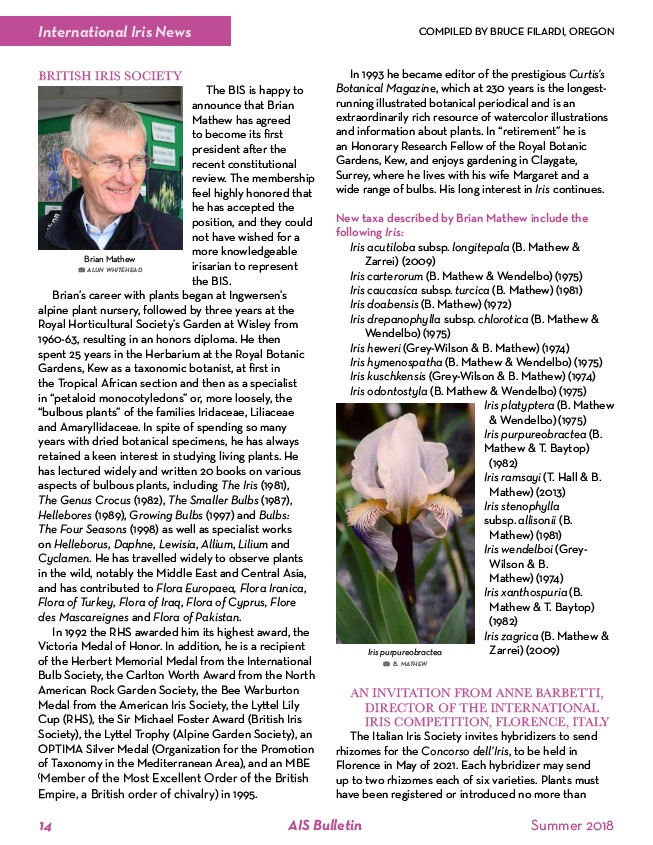
International Iris News COMPILED BY BRUCE FILARDI, OREGON
BRITISH IRIS SOCIETY
The BIS is happy to
announce that Brian
Mathew has agreed
to become its first
president after the
recent constitutional
review. The membership
feel highly honored that
he has accepted the
position, and they could
not have wished for a
more knowledgeable
irisarian to represent
the BIS.
Brian Mathew
, alun whitehead
Brian’s career with plants began at Ingwersen’s
alpine plant nursery, followed by three years at the
Royal Horticultural Society’s Garden at Wisley from
1960-63, resulting in an honors diploma. He then
spent 25 years in the Herbarium at the Royal Botanic
Gardens, Kew as a taxonomic botanist, at first in
the Tropical African section and then as a specialist
in “petaloid monocotyledons” or, more loosely, the
“bulbous plants” of the families Iridaceae, Liliaceae
and Amaryllidaceae. In spite of spending so many
years with dried botanical specimens, he has always
retained a keen interest in studying living plants. He
has lectured widely and written 20 books on various
aspects of bulbous plants, including The Iris (1981),
The Genus Crocus (1982), The Smaller Bulbs (1987),
Hellebores (1989), Growing Bulbs (1997) and Bulbs:
The Four Seasons (1998) as well as specialist works
on Helleborus, Daphne, Lewisia, Allium, Lilium and
Cyclamen. He has travelled widely to observe plants
in the wild, notably the Middle East and Central Asia,
and has contributed to Flora Europaea, Flora Iranica,
Flora of Turkey, Flora of Iraq, Flora of Cyprus, Flore
des Mascareignes and Flora of Pakistan.
In 1992 the RHS awarded him its highest award, the
Victoria Medal of Honor. In addition, he is a recipient
of the Herbert Memorial Medal from the International
Bulb Society, the Carlton Worth Award from the North
American Rock Garden Society, the Bee Warburton
Medal from the American Iris Society, the Lyttel Lily
Cup (RHS), the Sir Michael Foster Award (British Iris
Society), the Lyttel Trophy (Alpine Garden Society), an
OPTIMA Silver Medal (Organization for the Promotion
of Taxonomy in the Mediterranean Area), and an MBE
(Member of the Most Excellent Order of the British
Empire, a British order of chivalry) in 1995.
In 1993 he became editor of the prestigious Curtis’s
Botanical Magazine, which at 230 years is the longestrunning
illustrated botanical periodical and is an
extraordinarily rich resource of watercolor illustrations
and information about plants. In “retirement” he is
an Honorary Research Fellow of the Royal Botanic
Gardens, Kew, and enjoys gardening in Claygate,
Surrey, where he lives with his wife Margaret and a
wide range of bulbs. His long interest in Iris continues.
New taxa described by Brian Mathew include the
following Iris:
Iris acutiloba subsp. longitepala (B. Mathew &
Zarrei) (2009)
Iris carterorum (B. Mathew & Wendelbo) (1975)
Iris caucasica subsp. turcica (B. Mathew) (1981)
Iris doabensis (B. Mathew) (1972)
Iris drepanophylla subsp. chlorotica (B. Mathew &
Wendelbo) (1975)
Iris heweri (Grey-Wilson & B. Mathew) (1974)
Iris hymenospatha (B. Mathew & Wendelbo) (1975)
Iris kuschkensis (Grey-Wilson & B. Mathew) (1974)
Iris odontostyla (B. Mathew & Wendelbo) (1975)
Iris platyptera (B. Mathew
& Wendelbo) (1975)
Iris purpureobractea (B.
Mathew & T. Baytop)
(1982)
Iris ramsayi (T. Hall & B.
Mathew) (2013)
Iris stenophylla
subsp. allisonii (B.
Mathew) (1981)
Iris wendelboi (Grey-
Wilson & B.
Mathew) (1974)
Iris xanthospuria (B.
Mathew & T. Baytop)
(1982)
Iris zagrica (B. Mathew &
Zarrei) (2009)
Iris purpureobractea
, b. mathew
AN INVITATION FROM ANNE BARBETTI,
DIRECTOR OF THE INTERNATIONAL
IRIS COMPETITION, FLORENCE, ITALY
The Italian Iris Society invites hybridizers to send
rhizomes for the Concorso dell’Iris, to be held in
Florence in May of 2021. Each hybridizer may send
up to two rhizomes each of six varieties. Plants must
have been registered or introduced no more than
14 AIS Bulletin Summer 2018